As an app owner, you have multiple options to make money with your app. Selling in-app purchases (IAPs) is a very common way. Most developers prefer selling IAPs over selling premium apps because the potential for generating revenues is unlimited.
But to unlock this potential, you need to optimize your in-app purchases. Approaching users in the right way, and offering them the right packages at the right price points is a complex task, and there are multiple pitfalls on the way that you should avoid.
SO, HOW DO YOU OPTIMIZE YOUR IN-APP PURCHASES?
To optimize your in-app purchases and make more money from your app, you need to take care of four tasks that consist of multiple subtasks.
- Respect Psychological Price Barriers
- Create IAPs for all Price Segments
- Pick the Right Price for the Cheapest Package
- Adjust Prices for Mid- and High-Value IAPs
- Pro Strategy: Use Decoy Package
- Make it easy to Access Your Shop
- Introduce Your Premium Content during Onboarding
- Offer Your IAPs actively at the Right Time
- Let Users enjoy Premium Content without Paying
How to Set the Right Prices
Obviously, prices are crucial factors for your IAP strategy. Finding the right price points will attract more users to buy and thus increase conversion rates, but also maximize your revenues.
Respect Psychological Price Barriers
When validating prices, users are prone to psychological biases. They judge prices primarily by the first digit (the digit on the very left). Because of that, they perceive $19.99 as much more beneficial than $20, although the price difference is only one cent. The perceived difference is even bigger when they compare one-digit prices like $9.99 to two-digit prices like $10.
Price barriers are usually even numbers ending on nil, for instance, $10, $20, $50, and $100. When planning your pricing strategy, you should respect these psychological price barriers. Set your IAP prices slightly below these barriers, so users will perceive them as better deals than prices slightly above these barriers. For instance, go for $9.99 instead of $11.99, and for $19.99 instead of $20.99.
Create IAPs for all Price Segments
Besides the psychological price barriers, users tend to have individual price sensitivities. According to their personal financial situation and spending behavior, they might avoid buying items above specific price points. Users with a high price sensitivity will rather pick cheap items, while users with a low price sensitivity will be open to purchase expensive IAPs as well.
These preferences reflect in actual buying behavior in the app stores. In general, users will prefer the cheapest in-app purchase. And the more expensive packages are, the less often will users buy them. So, most users have a rather high price sensitivity.
Nevertheless, you should offer expensive packages to maximize the revenue you make from people with low price sensitivity.
In general, try to create at least one in-app purchase for each of these three segments:
- Low-value packages that cost less than $5.
- Medium-value packages that cost more than $5, but less than $50.
- High-value packages that cost $50 or more.
Pick the Right Price for the Cheapest IAP
The price of the cheapest IAP is a crucial value because it is the basis of your IAP strategy for two reasons:
First, most users will choose this package when doing their first purchase. So it will be the entry point from the free user to the paying customer segment. Or in simple words, it determines how much money users have to pay at least to benefit from your premium features (or currency).
Second, users will compare the prices of more expensive packages to the cheapest package to find out which one offers the best benefits. So the price of the cheapest package will determine how favorable users perceive the other IAPs.
Using a price of $0.99 seems to be a nice loss-leader price. It is so low that most people afford to pay it, so the risk connected to it is rather low.
But actually the same argument is valid for prices of $3.99 or $4.99. Only a few users will consider these price points as too high for a first time purchase.
Let us assume you raise the price of the cheapest package from $0.99 to $4.99. This will increase your revenues from buyers of this package by 400%. And even if the conversion rate cuts in half (what is unlikely to happen), you will still make more money than before.
So do not make your basis IAP too cheap. I would recommend a price of $3.99 or $4.99.
Adjust Prices for Mid- and High-Value IAPs
When composing your mid- and high-value IAPs, it is important to make them attractive. You must give users a reason for choosing expensive packages over cheap packages. For this purpose, give them discounts or provide additional value. Here are some ways how to do that:
- For consumables like in-app currency, use a lower per-unit price. For instance, if your cheapest package contains 100 gold coins and costs $4.99 ($0.05 per gold coin), give users 500 gold coins for $19.99 ($0.04 per gold coin).
- For subscriptions, offer lower per-month prices for long-term packages. If the 1-month subscription costs $2.99, give users the 12-month subscription for $29.99 ($2.49 per month).
- For non-consumables, create bundles of single items with a price that is lower than the combined single prices. So if you sell two packages of content at $4.99 each, create a bundle of both for $8.99. Alternatively, add an extra item in the bundle, so it provides more value than the two single items.
The more expensive a package is, the higher its added value should be. So an IAP for $29.99 should come along with more extra items (non-consumables) or a bigger per-unit discount (consumables, subscriptions) than a $19.99 package. And a package for $49.99 should outdo both of them.
Make sure to pick reasonable discount rates, though. Giving 70%, 80% or 90% is unreasonable and will hurt your revenues in the long term. Many app owners give discounts between 20% and 35% for their most expensive IAPs. If you price your high-value IAPs within this range, you will be fine.
Pro Strategy: Use Decoy Packages
Price sensitivity might keep users away from your high-value IAPs. But with a simple trick, you can make a high-value package appear much more beneficial, so more people buy it. Let me explain how it works, based on the example with the two packages of 100 and 500 gold coins.
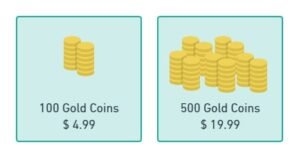
Example of Two IAPs without Decoy Package
In this scenario, most users will buy the 100 coins package because it is significantly cheaper than the 500 coins package.
No, you create a new IAP that contains significantly less premium currency than the high-value package you want to push. But you select a price that is only slightly lower. In our example, we add a 400 coins package for $17.99.
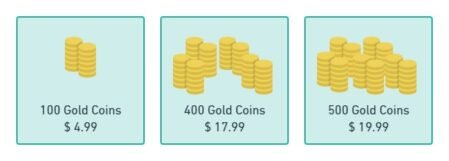
Example of Three IAPs including Decoy Package
Now, users will compare the expensive package to the new decoy package. They will realize that they will get way 100 extra coins if they pay only 2 Dollars more. With this change, more users will pick the high-value IAP, because it appears to be a much better deal in comparison with the new package.
HOW TO DESIGN YOUR IN-APP SHOP
Besides picking the right price points for your IAPs, you also need to present them in a proper way. Your app’s shop must be easy to use, informative, and appealing. The following measures will help you increase conversion rates and revenues.
Visualize IAP Content
Make clear to users what they buy by visualizing your IAPs’ content. Show the items that the packages contain. For consumables, make the single IAPs distinguishable. Have a look at the screenshot from the Clash of Clans shop. Each of their gem packages shows a picture that indicates the IAP’s value.
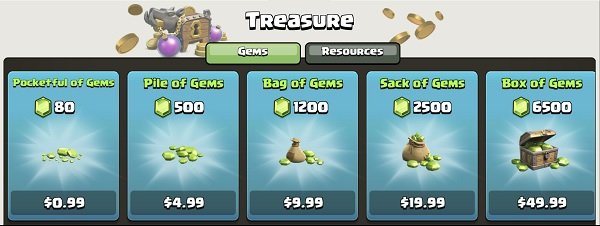
IAP Shop of Clash of Clans
Make sure to display your IAPs either in ascending or descending order. I recommend to start with the cheapest and display the other packages in ascending order. If you start with the most expensive, the high prices might put off some users. Showing them affordable packages first reduces this risk.
Use the Power of Colors
Colors impact people and their behavior unconsciously, and thus, they are an important tool in all marketing disciplines. If you use them properly in your in-app shop, you can increase conversion rates and revenues for your apps. Here are some basic tips:
- Blue is a color of trust and reliability that calms viewers down. That is why you can find many company logos that contain blue in the finance industry (Deutsche Bank, Bank of America, Visa, Paypal, etc.). Blue makes a good background color for your in-app shop.
- Green stands for life and nature. Like blue, it has a calming effect. Green is, in general, a good choice for CTAs like the Buy-button.
- Yellow and Orange are attention-grabbing colors that are connected to joy and happiness. They are great for setting small highlights in your shop.
- Red is an intense, alarming color that communicates urgency. It is a great choice to emphasize temporary or limited offers.
- Gold, Violet, and Black symbolize wealth, luxury, and exclusivity. If you want to point out the high value of your most expensive IAPs, use these colors as background, border, or text colors.
Do not overdo your design optimizations. Using too many different colors, highlights, and eye-catchers will create a confusing and unpleasant experience. So try to keep it simple.
Communicate the Added Value
For some users, the extra value of mid- and high-value in-app purchases will be obvious. But many users will not invest time and effort to calculate which package offers the best value. Thus, it is important to communicate each package’s benefits explicitly so users understand them at first glance.
Doing so is especially important for consumable IAPs because they usually contain different quantities of the same item or currency. Thus, they are comparable easily. In general, you have two options to compare mid- and high-value IAPs to the package with the lowest price:
Method 1: State the discount on a per-unit basis in relation to the per-unit price of the cheapest package.
Method 2: Tell users how big the bonus (the amount of free currency) in comparison to the per-unit price of the cheapest package is.
But which of these approaches is better? Let us make a quick calculation to find the answer. We will use the example of our packages again:
- Package 1: 100 gold coins for $ 4.99 (base price: $0.05 per gold coin)
- Package 2: 500 gold coins for $ 19.99 (base price: $0.04 per gold coin)
Method 1: Discount
At the regular base price, 500 coins would cost $24.99 ($0.05 x 500). So with the actual price of $19.99, users get a discount of $5 or 20% ($5 / $24.99).
Method 2: Bonus
At the regular base price of $0.05 per coin, users would get 400 coins for $19.99. As the actual amount they get is 500 coins, the free bonus is 100 coins. This equals 25% (100 coins / 400 coins).
So the answer is clear: With the bonus method, you can always state higher numbers than with the discount method. This will increase the perceived value of mid- and high-value IAPs for your users.
Set Highlights
To make sure users recognize it, always highlight the added value. Use colors that stand out from their environment. As said before, yellow, orange and red are good picks in most cases.
The makers of Farmville 2 follow the bonus-method. For each coin package, they display the bonus in comparison to the base price of the cheapest package.
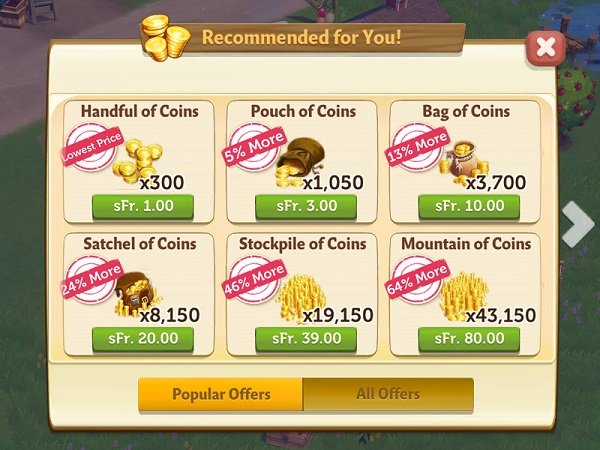
In-App Shop of Farmville 2
In addition, you can use colorful badges to point users to specific IAPs. For instance, many app owners use badges saying “most popular” or “best deal” to highlight single packages. The claim “best deal” bases on the per-unit price of a package and is an objective fact. Thus you should only use it for IAPs that actually provide the best conditions. But claims like “most popular” usually are not provable. So you can use them for any package that you want to promote. I suggest using it for a mid-value package.
Check out the screenshot from the iOS game Dawn of Titans that shows two IAPs with promotional badges.
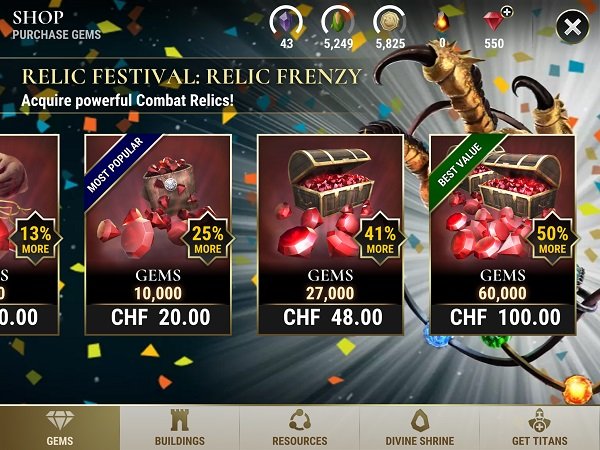
In-App Shop of Dawn of Titans
HOW TO PROMOTE YOUR IAPS
The measures we have discussed so far aim at your in-app shop. So they only affect users who open your shop. But people will only do so if they know about it. So to optimize your revenues, you must make users aware of your IAPs. Here are some ways to do so:
Make it easy to Access Your Shop
Make sure users can find your shop easily. Place an icon that leads to it on your app’s home screen if possible. Your shop should never be more than two clicks away for the user. See another screenshot of Clash of Clans below. On the game’s homepage, you can see the shop icon in the bottom right corner. It is clearly visible and easily accessible.
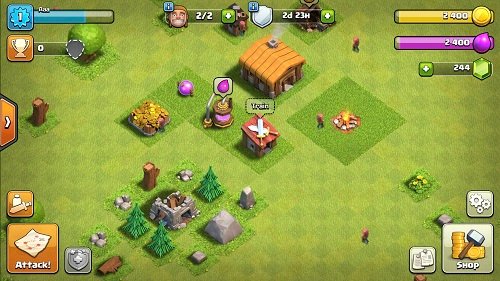
Homepage of Clash of Clans
Introduce your Premium Content during Onboarding
To make users familiar with your app, you should have an onboarding process or a tutorial that explains its functions. It makes perfect sense to include your in-app currency during this process. Explain to users the following points:
- how to use your in-app currency
- which benefits it provides
- how to navigate to your in-app shop
Offer your IAPs actively at the Right Time
Even when you’ve introduced your content during the onboarding process, you should remind users of your premium content afterward. But it is crucial to do it at the right time. If you do it wrong, you will annoy users and harm their experience. Follow these rules to promote your premium content:
- Do not promote IAPs too early. Give users time to learn how your app works and enjoy its benefits. Give them at least a couple of days before you start promoting your IAPs.
- Do not be too aggressive. Users will not buy just because you spam them with promotions.
- Never interrupt the user experience. If a user is in the middle of playing a level in your game, pushing an IAP into his faces will not make him buy. It is more likely he will get angry because you harm his experience.
- Instead, offer IAPs when they actually help. When the user fails to complete the level, it is the right time to offer him an item that helps him complete it next time.
This approach also works for non-gaming apps. Tinder offers an in-app currency called Superlike that helps users attract the attention of other users. But when people try to use this function without having Superlikes available, Tinder asks them to buy an IAP.
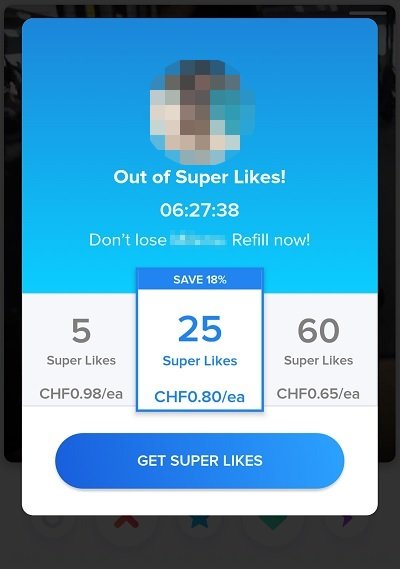
IAP Prompt of Tinder
Let Users enjoy Premium Content without Paying
Users who are not sure about the benefits of premium currency or premium content might shy away from purchasing it. Giving them the chance to test these benefits can convince some of them to buy and result in a higher payer conversion.
There is a common approach to let users learn about the benefits of a subscription: Give them a free trial. If they can consume premium content for a week or a month, there is a good chance that they do not want to miss it anymore and thus will pay for it afterward.
For consumables such as in-app currency, you have several options to provide free samples:
- I already mentioned one of them: Provide free currency during the tutorial or onboarding process. Give users enough of it so they can use it for a limited time even after completing the onboarding.
- Reward users for continuously using your app with a daily login bonus. Especially in games, users receive in-app items when they open the app, and they will get bigger rewards if they do so repeatedly.
- Give them premium currency for completing simple tasks that help your business, for instance sharing app content on social media or subscribing to your newsletter.
- Implement rewarded ads into your app. When users watch rewarded video ads or complete tasks from an offer wall like installing a new app, they will get a small amount of premium currency and can enjoy its benefits. In addition, you will increase your ad revenues. So even if users decide to not buy IAPs, you will monetize them.
Be aware that all of these measures can cannibalize your revenues from IAPs if you give away too much premium content for free. You need to find a proper balance: Give users enough free samples to let them learn about the premium content’s benefits in the short term. But make sure there is a shortage in the long term that users only can overcome by buying IAPs.
HOW TO OFFER SPECIAL PACKAGES
Your regular in-app purchases are the basement for your revenues. But you can create additional special packages that are not available permanently to increase revenues further. Adding special packages has two goals:
- Increasing the payer conversion rate by encouraging non-payers to make a purchase.
- Boosting revenues temporarily.
Here are three strategies for special offers:
Do General Sales
Temporary sales that address all users are a good way to increase your revenues in the short term. These offers also have the potential to attract new buyers and increase your conversion rate.
During a sale, you can either sell your regular IAPs at lower prices or you can offer new packages, created especially for this occasion. The first option is usually better. For users, it is easier to compare the sales price to the regular price of the same package than comparing a new IAP to the regular packages. Also, it is easier to communicate the added value of the discounted offers.
To make the most out of your sales, follow these rules:
- Make your sales rare and unpredictable. If users can predict when the next sale takes place, they will avoid buying at regular prices and postpone their purchases until the next sale. This behavior will boost your revenues during the sale, but in sum, you will lose money. Thus, do not offer sales regularly and do not announce them upfront.
- Give users a feeling of urgency by making your sales short. Limit them to one or two days maximum. For games, a weekend sale is a good idea, because users have more time to play and enjoy the purchased items in their leisure time. In any case, display a countdown to let users know when the sale will end.
- Communicate your sales. As soon as the discounted offers are available, let users know about them via push notifications, in-app messages, and newsletters. You can also announce your sales on social media, but this is a risky tactic. Especially users of mobile games often do not like in-app purchases because they consider them to favor pay-to-win. Communicating sales or other IAP-related messages via social media might trigger them to post negative comments.
- Place sales packages prominently in your shop. Users should see them immediately after opening the shop. So place your sales IAPs on the shop’s first page.
- Make your sales packages visible. Use a special border or background color to highlight them in contrast to the regular packages. You can also add small badges saying “Sale” or “Special Offer” to attract users’ attention. Besides, state the discounts or the crossed-out original prices, so users understand how much money they save.
The screenshot below shows a sales package from Last Day on Earth including a red SALE badge, the crossed-out original price, and a second badge stating the discount.
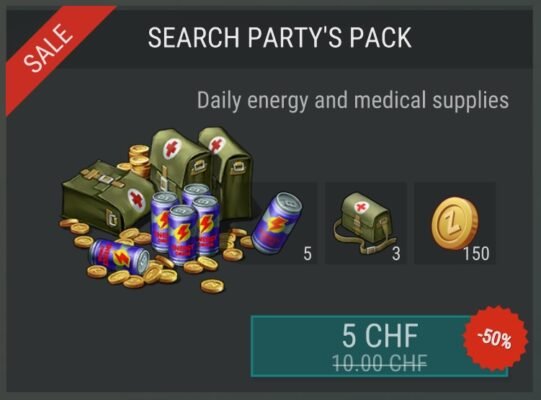
Sales Offer from Last Day on Earth
Offer Starter Packs
While general sales address all users at the same time, individual offers are a good way to approach single users in specific situations. Especially for games, this is a common and useful strategy to increase conversion rates and revenues.
Starter packs aim to convert new users into buyers early in their journey. To reach this goal, they must be very attractive. To make them attractive, make sure they fulfill a couple of requirements:
- Make starter packs available only for a short period of time after users open the app for the first time. This period needs to be long enough to give them the chance to learn how your app works and enjoy its benefits though. Typically, a period of 24 to 72 hours is reasonable. Again, a countdown helps to create a feeling of urgency and the fear to miss out on a great chance.
- Make starter packs unique. Create a bundle of items that users can only get when buying the starter pack. Combine subscriptions, non-consumables, and consumables if it makes sense.
- Offer a great discount. If you combine single IAPs in your starter pack, offer it at a massive discount. Converting users into buyers early in their journey is extremely valuable for you because it increases the chance of follow-up purchases. Thus, giving discounts of up to 90% is fine for starter packs.
- Place the starter pack prominently and make it visible in the in-app shop. It should be the first IAP that users see in the shop. Also, place an icon or a badge that promotes the starter pack on new users’ home screens.
Below you can see another example from Dawn of Titans. In their Starter Bundle, the developers combine a unique character with additional non-consumables as well as in-app currency. The package is available for three days at a 90% discount.
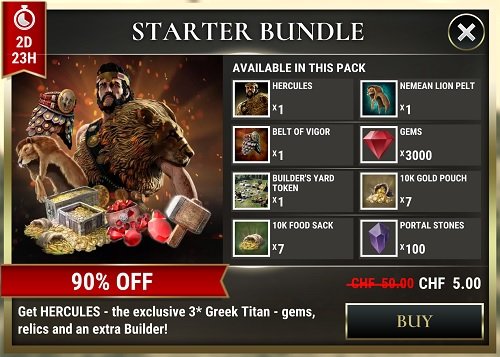
Starter Pack from Dawn of Titans
Offer Individual Packages
Besides the starter pack, it might make sense to offer contextual IAPs to individual users. These packages should be available only for a limited period of time and offer something unique at an attractive price.
You can create special packages based on these characteristics:
- If you own an app that offers a broad variety of content, create IAPs based on users’ interests and their behavior in the past. For instance, if someone has accessed free abs exercises in your fitness app repeatedly, offer him a package that contains premium abs exercises.
- The same approach works for game genres like strategy or RPG that allow different playstyles. Tailor packages with items that help players who follow one specific playstyle. For instance, if users can play an archer in an RPG, create an IAP that contains equipment that especially benefits these players.
- Create IAPs for special events and distribute it only to players that opt-in to these events. The screenshot below shows a season-specific package from the game Last Day on Earth.

Season IAP from Last Day on Earth
Finally, identify users who make purchases regularly and generate high revenues for you. Offer them special high-value packages at better conditions than the regular IAPs.
CONCLUSION
By following the tips in this article, you will increase the revenue potential for your in-app purchases significantly. However, you should analyze your users’ purchase behavior constantly and optimize your offers according to your learnings. A/B testing different IAPs against each other is one way to do so.
Besides the adjustments discussed in this article, also make sure to optimize your non-consumable and subscription IAPs for search. By doing so, you can improve your app’s visibility in search results.
